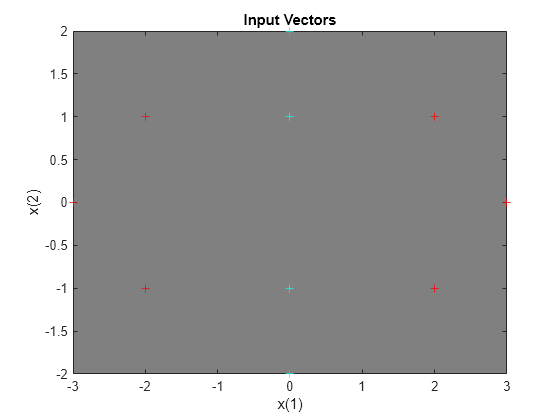学习向量量化
LVQ 网络训练为根据给定目标对输入向量进行分类。
令 X 为 10 个二元素样本输入向量,C 为这些向量所属的类。这些类可以通过 IND2VEC 变换为用作目标 T 的向量。
x = [-3 -2 -2 0 0 0 0 +2 +2 +3;
0 +1 -1 +2 +1 -1 -2 +1 -1 0];
c = [1 1 1 2 2 2 2 1 1 1];
t = ind2vec(c);下面绘制了这些数据点。红色 = 第 1 类,青色 = 第 2 类。LVQ 网络表示具有隐藏神经元的向量聚类,并将这些聚类与输出神经元组合在一起以形成期望的类。
colormap(hsv); plotvec(x,c) title('Input Vectors'); xlabel('x(1)'); ylabel('x(2)');

在以下代码中,LVQNET 创建了一个具有四个隐藏神经元的 LVQ 层,学习率为 0.1。然后针对输入 X 和目标 T 配置网络。(配置通常不是必要步骤,因为 TRAIN 会自动完成配置。)
net = lvqnet(4,0.1); net = configure(net,x,t);
按如下方式绘制竞争神经元权重向量。
hold on w1 = net.IW{1}; plot(w1(1,1),w1(1,2),'ow') title('Input/Weight Vectors'); xlabel('x(1), w(1)'); ylabel('x(2), w(2)');

要训练网络,首先改写默认的训练轮数,然后训练网络。训练完成后,重新绘制输入向量“+”和竞争神经元的权重向量“o”。红色 = 第 1 类,青色 = 第 2 类。
net.trainParam.epochs=150; net=train(net,x,t);

cla; plotvec(x,c); hold on; plotvec(net.IW{1}',vec2ind(net.LW{2}),'o');

现在使用 LVQ 网络作为分类器,其中每个神经元都对应于一个不同的类别。提交输入向量 [0.2; 1]。红色 = 第 1 类,青色 = 第 2 类。
x1 = [0.2; 1]; y1 = vec2ind(net(x1))
y1 = 2